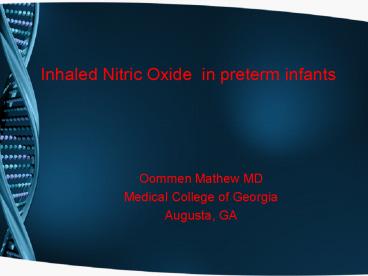Inhaled Nitric Oxide in preterm infants - PowerPoint PPT Presentation
1 / 31
Title:
Inhaled Nitric Oxide in preterm infants
Description:
Oommen Mathew MD Medical College of Georgia Augusta, GA Nitric oxide properties Clear, odorless gas Generally considered an environmental pollutant Cigarette smoke ... – PowerPoint PPT presentation
Number of Views:408
Avg rating:3.0/5.0
Title: Inhaled Nitric Oxide in preterm infants
1
Inhaled Nitric Oxide in preterm infants
- Oommen Mathew MD
- Medical College of Georgia
- Augusta, GA
2
Nitric oxide properties
- Clear, odorless gas
- Generally considered an environmental pollutant
- Cigarette smoke 400-1000 ppm
- Free radical
- Diffuses easily across cell membrane
- Intracellular messenger
- High affinity for hemoglobin
- Short half-life(3-5 s) and unstable
- Potent vasodilator
3
Nitric oxide properties
- NO is a gas with no known cellular storage
mechanism - NO is the lowest molecular weight human cell
product - Widely distributed CNS, Epithelial cells of
lung, kidney, stomach, pancreas, uterus
4
(No Transcript)
5
iNO metabolism
- Combines with HgB to form Met HgB
- Reacts with oxygen to form Nitrites (NO-2)
- and Nitrates (NO-3)
- Nitrates are excreted by the kidneys (gt70 of
iNO) - Loss in exhaled air
6
Why use iNO in preterm infants?
- NO mediates normal lung growth
- Anti-inflammatory effects
- Improves early pulmonary function
- Modifies lung growth and elastin deposition
- Pulmonary NO production is decreased in BPD
- iNO decreases PPHN in patients with BPD
- Surfactant dysfunction in BPD is improved by iNO
- Decreases protein leak in BPD
- Low dose iNO is an antioxidant
7
Potential risks of iNO in preterm infants
- Increases bleeding time intracranial
hemorrhage - Oxidant lung injury with prematurity
- Low PVR left to right shunting
- Pulmonary edema,
pulmonary hemorrhage,
systemic hypoperfusion
8
Skimming 1997
9
Van Meurs 1997
10
Cheung 1998
11
Cheung 1998
12
Banks 1999
13
(No Transcript)
14
Subhedar 1997
15
Mercler et al 1999
16
Kinsella et al 1999
17
Schreiber et al 2003
18
Schreiber et al 2003
19
Van Meurs 2005
20
Van Meurs 2005
21
Field 2005
22
Hascoet et al 2005
23
(No Transcript)
24
Mestan 2005
25
iNO for respiratory failure in preterm infants
- 7 randomized trials
- Short term improvement in oxygenation
- No difference in BPD or mortality
26
Kinsella 2006
27
Kinsella 2006
28
Ballard 2006
29
No differences in PDA, NEC, ROP, Sepsis
Ballard 2006
30
When to say No to iNO
- Patients with TAPVR (obstructed)
- Patients with pulmonary veno occlusive disease
- Neonates dependent on R to L shunt
- Severe L ventricular failure
- Significant bleeding diathesis
- Severe thrombocytopenia
- Severe IVH
31
iNO in Preterm Infants
- Where do we go from here?
- iNO appears to be effective in less sick infants,
noncaucasian infants and more mature infants
(gt1000g) - Rescue treatment improves oxygenation but not
outcomes - iNo may be neuroprotective in a subset of preterm
infants - Should we consider prophylactic or early
rescue iNo in preterm infants at risk for
adverse outcomes? - Should we combine with surfactant treatment?































